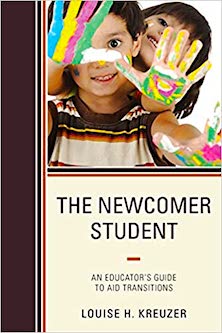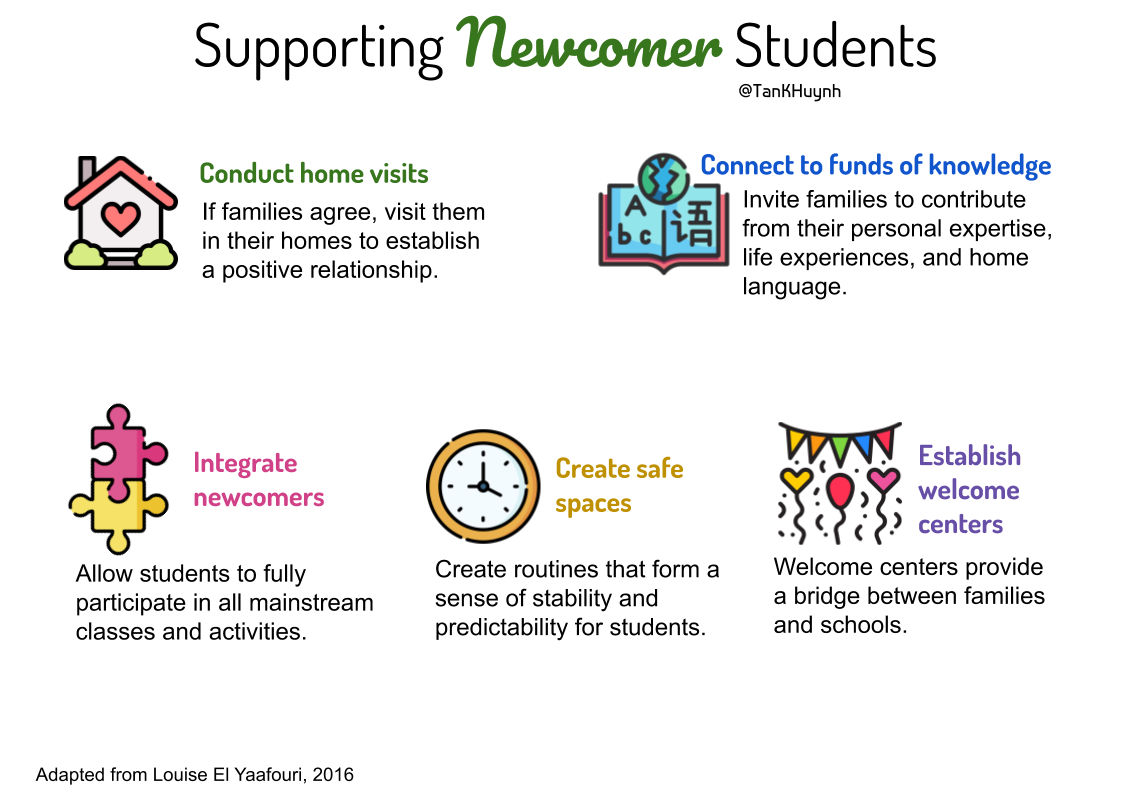How We Can Support Our Newcomer Students

Louise El Yaafouri (@ElYaafouriCLDE) wrote The Newcomer Student with the hopes of providing teachers and school districts with strategies to not only welcome newcomer students but to create a system that empowers them and their families to thrive.
In the new year, we may see a fresh influx of child immigrants into U.S. schools. This article serves as extensive show notes capturing the key ideas that Louise shared during our podcast conversation.
Home Visits
Louise talked about the need to have families be our partners. One way to do that is through home visits.
Imagine that you are new to a country, and you don’t speak the language. You might not know anyone outside of your immediate family members residing in your house. You are not familiar with that country’s societal institutions, such as grocery stores, doctors’ offices, banks, and schools.
Now imagine having someone come and visit you at your home to communicate that you have them as an ally. How much more relieved would you feel?
That is the exact reason why Louise recommends making home visits so that families feel that they have someone who they can trust and know that someone is there for them. In this case, families will know that they have someone who will care for their child. (You can read Louise’s article on home visits at Educational Leadership magazine.)
Louise recommended that we follow these tips when going on home visits:
- Go with a colleague
- Have key points you want to share
- Learn a key phrase
- Learn a few cultural customs
Until the COVID-19 pandemic subsides, a possible alternative to home visits is to have video conferences. If families have access to technology, use video conferences to establish a relationship. If families do not have the technology, they might be able to partner with the technology office to request devices on loan.
Funds of Knowledge
One of the deadliest myths around language learners and newcomers is that they are already behind, particularly academically. Families may think that they are not able to support their children at school because they do not know the language.
However, families can do a lot to support their children’s literacy development by simply reading stories, telling stories, or engaging in robust conversations in their home language. When families do this, they establish the cognitive foundation of literacy that can be transferred to literacy in another language (Cummins, 1979).
Funds of knowledge can also be the lens through which we view students (Gonzalez, Moll, & Amanti, 2005). View students as coming laden with rich life experiences, cultural practices, and interests that can be the foundation on which to build, the gate which to walk through, or the latch which to connect to. This approach is much more affirming and nurtures a relationship with students rather than prejudging them as lacking, behind, or limited. The latter could not be farther from the truth.
Some additional ways to tap into families’ funds of knowledge include:
- Inviting relatives to share an expertise that is connected to the unit’s concept
- Encouraging families to talk to their children about their experiences that are connected to the unit
- Having families share traditions and stories that are thematically connected to the unit
- Inviting families to give tours of their place of employment if it is conceptually connected to the unit
Creating a safe space
Among the various things we can do to make students feel safe in our classes, one of the most important is establishing routines. Routines form a sense of predictability, which leads to a sense of safety as students do not have to keep learning new routines for each class.

In addition, we can do things such as making sure to learn how to pronounce students’ names the way they prefer and possibly learning a few phrases in their home language.
Integrating students into the community
Another thing we can do for newcomers is to integrate them into the learning community as much as possible. Academically, when students have been separated from participating in mainstream classrooms, they are often held to less rigorous standards and do not engage with grade-level content, further widening the achievement gap (Fenner & Snyder, 2017; Nora & Echevarría, 2016).
Louise said that it is appropriate to take an hour out of the day for cultural orientation, but the location that provides students with the greatest opportunities for rich language and cognitive engagement is in the content classes since they provide the context for language use.
Students know when they are being held to lower expectations because they compare the learning experiences they have with that of their peers. Instead of lowering the expectations, we need to increase the types and amount of scaffolding we’re providing and offer more entry points to the content such as through students’ home languages.
Establishing a welcome center
Create a welcome center for families to learn about the cultural and societal practices valued by the community and school. Use the welcome center to teach what schooling looks like, feels like, and sounds like. Louise recommended creating a simple book with photos and a single sentence to describe what each photo communicates.
Also, communicate the resources available to the family, such as bussing schedules, laundry centers, food pantries, thrift stores, evening language classes, and advocacy groups. As an institution in the community, the school can serve as a bridge between families and the larger community.
Please note that a welcome center is parent-facing and is not to be used as a warehouse for newcomer students. Newcomer students need to be fully integrated into schools so that they are ensured a more equitable learning experience.
We must bridge the gap
As teachers, we work at schools. Yet, schools are more than just centers for learning. Schools must bridge the gap between home and community for newcomers. We have the unique responsibility and opportunity to welcome students and their families, smooth their transition into the community, and provide them with the highest quality of education to prepare them to be contributing members of a democratic society.
We have a tall task before us, yet it is a meaningful, fulfilling one.
References
Cummins, J. (1979). Linguistic interdependence and the educational development of bilingual children. Review of Educational Research, 49(2) 222–251. https://doi.org/10.2307/1169960
Fenner, D. S. & Snyder, S. (2017). Unlocking English learners potential: strategies for making content accessible. Thousand Oaks, CA: Corwin, a SAGE Company.
Gonzalez, N., Moll, L. C., & Amanti, C. (Eds.). (2005). Funds of knowledge: Theorizing practices in households, communities, and classrooms. Mahwah, NJ: Lawrence Erlbaum.
Nora, J., & Echevarría J. (2016). No more low expectations for English learners. Portsmouth, NH: Heinemann.



































